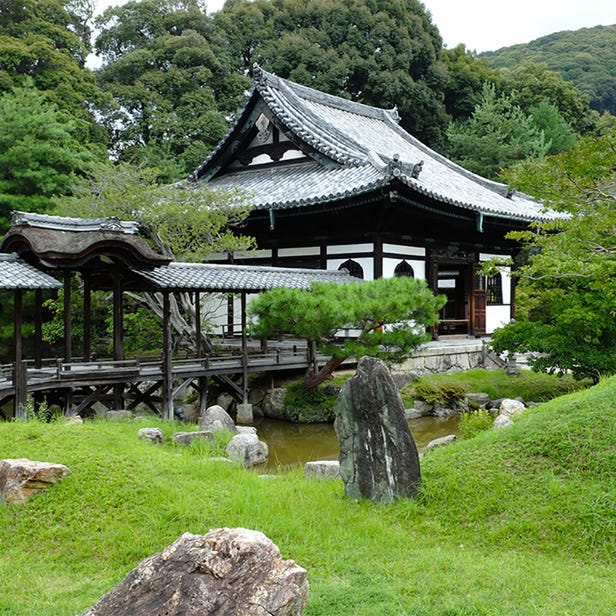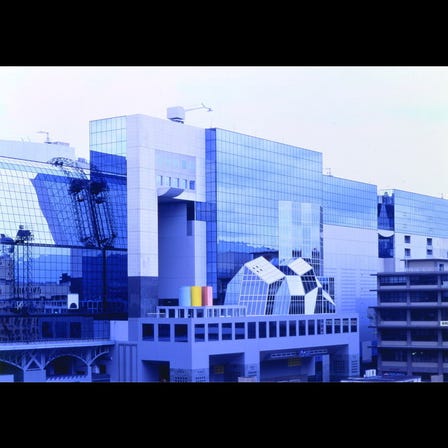Description
After Hideyoshi Toyotomi died in 1598, Kodai-ji Temple was founded in 1606 by his wife, Kita-no-Mandokoro (also known as Nene) to pray for his happiness in the afterlife. The temple construction was supported with his political power by Ieyasu Tokugawa, Hideyoshi's chief vassal and later Shogun of Japan and structures such as Main Building, Tea House, and Dressing Palace were relocated from Fushimi-jo Castle which Hideyoshi had lived. As such, the temple was resplendent and magnificent at the time of its construction. However, some structures, including the Main Building, were lost to fire in later years. Nevertheless, many structures remain in their original states, such as Otama-ya (Sanctuary) where Hideyoshi and Nene are enshrined, Kaisando (Founder's Hall), and the two teahouses of Kasa-tei and Shigure-tei, which were designed by Sen no Rikyu. Located across Nene-no-Michi is Kodai-ji Temple's sub temple, Entoku-in Temple, which is well-known as the place where Nene spent her last days.
・Nicknamed Maki-e Temple for the vast number of maki-e furnishings that were owned by Nene
Within Otama-ya (Sanctuary) where Nene rests, the dais and shrine are adorned with the exquisite Kodai-ji Maki-e. This technique of maki-e (lacquer decorated with gold or silver powder) features pictorial designs using maki-e techniques hiramaki-e (flat lacquering) and enashiji (design areas filled with the sprinkled pear skin pattern usually reserved for backgrounds). Maki-es using the techniques above are collectively called Kodai-ji Maki-e because such revolutionary techniques were developed for Otama-ya during the Muromachi Period (16th century).
・Teahouses designed by Sen no Rikyu (Important Cultural Properties)
Kasa-tei and Shigure-tei are both teahouses designed by Sen no Rikyu (in his preferred styles) that were transferred from Fushimi-jo Castle. Kasa-tei has a pyramidal, thatched roof and the interior ceiling is made of bamboo. Meanwhile, Shigure-tei is a two-storied structure, which is rare among teahouses. The two buildings are connected via a roofed walkway.
・Visitors can enjoy the Kangetsu-dai (Moon-viewing Pavilion) built on the pond and the beauty of the garden framed by fall colors
Engetsu-chi and Garyo-chi ponds, which are located on either side of the Kaisando (Founder's Hall), and the surrounding garden connected by two roofed corridors are popular among visitors in fall when the leaves change color. Built on Engetsu-chi Pond is the Moon-viewing Pavilion. To the north is a man-made island called Kame-jima and off the peninsula to the south is Tsuru-jima. Famous as the garden landscaped by Enshu Kobori, the tea ceremony master representing the Momoyama and Edo Periods, this garden is designated as a Historic Site and Place of Scenic Beauty.
・Nene-no-Michi is a popular Higashiyama destination where visitors can experience the refined charms of Kyoto (Historic Building Preservation Area)
Nene-no-Michi is a stone-paved street located at the bottom of Daidokoro-zaka, the stone steps connecting Kodai-ji Temple and Nene's home, Kesho Goten (Dressing Palace; currently Entoku-in Temple). This was originally part of the temple complex and is connected to Yasaka-jinja Shrine and Maruyama Park to the north. The area of the temple complex is said to have shrunk to a sixth or even a tenth of its original size, but it is an ideal place to pray for the former ruler of Japan. Nene-no-Michi is a popular sightseeing destination where visitors can experience the refined charms of Kyoto.
Location Information
-
- Address
-
526, Kodai-ji Shimokawaracho, Higashiyama-ku, Kyoto-shi, Kyoto, 605-0825
-
- Nearest Station
-
Gionshijo Station
・ Keihan Line
10 minutes on foot
-
- Phone Number
-
075-561-9966Available languagesonly in Japanese
-
- Hours
-
9:00am - 5:30pm
*Visiting hours*Reception ends at 17:00
-
- Closed
- None
-
- Public Site
- Official Site
Recommended Spots in Area
- Visiting
- Eating
- Shopping
- Lodgings
-
 The Yoshino Cherry Trees of the Philosopher’s WalkKyoto Station, To-ji TempleSpring
The Yoshino Cherry Trees of the Philosopher’s WalkKyoto Station, To-ji TempleSpring -
 Nishiki Market Shopping DistrictGion, Kawaramachi, Kiyomizu-dera TempleOther Sightseeing
Nishiki Market Shopping DistrictGion, Kawaramachi, Kiyomizu-dera TempleOther Sightseeing -
 Yasaka ShrineKyoto Station, To-ji TempleShrines
Yasaka ShrineKyoto Station, To-ji TempleShrines -
 Keage InclineGion, Kawaramachi, Kiyomizu-dera TempleOther Nature
Keage InclineGion, Kawaramachi, Kiyomizu-dera TempleOther Nature -
 Kiyomizu-dera TempleGion, Kawaramachi, Kiyomizu-dera TempleTemples
Kiyomizu-dera TempleGion, Kawaramachi, Kiyomizu-dera TempleTemples -
 Puppy Café Rio KyotoGion, Kawaramachi, Kiyomizu-dera TempleCulture Experience
Puppy Café Rio KyotoGion, Kawaramachi, Kiyomizu-dera TempleCulture Experience
-
Sushi Tamahime KYOTOKyoto Station, To-ji TempleJapanese cuisine
-
Kyoto Nama ChocolatGion, Kawaramachi, Kiyomizu-dera TempleChocolate
-
KembunrokuKyotoabanteiKyoto Station, To-ji TempleIzakaya
-
Shichijo Kanshundo ShazakissaKyoto Station, To-ji TempleOther Cafes and Sweets
-
GiontamejiroHachijoguchiKyoto Station, To-ji TempleSet Meal (Gozen)
-
Kaden Kyoame Gion KoishiGion, Kawaramachi, Kiyomizu-dera TempleOther Cafes and Sweets
-
BUYSELL Kyoto Shijo-dori storeGion, Kawaramachi, Kiyomizu-dera TempleClothing Stores
-
MUSASHI JAPAN Kyoto Sanjo Knife ShopGion, Kawaramachi, Kiyomizu-dera TempleHousehold Goods Stores
-
JR KYOTO ISETANKyoto Station, To-ji TempleDepartment Stores
-
Japan Culture & Character Shop Guf Kyoto storeGion, Kawaramachi, Kiyomizu-dera TempleGift Shops
-
JIKKO Cutlery PontochoGion, Kawaramachi, Kiyomizu-dera TempleHousehold Goods Stores
-
MUSASHI JAPAN Kyoto Shijo Knife ShopGion, Kawaramachi, Kiyomizu-dera TempleHousehold Goods Stores
-
DoubleTree by Hilton Kyoto StationKyoto Station, To-ji TempleHotels
-
Tabist Kiki Hotel Kyoto Gojo KarasumaKyoto Station, To-ji TempleEconomy Hotels
-
Six Senses KyotoKyoto Station, To-ji TempleHotels
-
Tawaraya RyokanNijo Castle, Kyoto Imperial PalaceRyokan
-
Rinn Hostel MiyagawachoGion, Kawaramachi, Kiyomizu-dera TempleEconomy Hotels
-
Sumiya RyokanNijo Castle, Kyoto Imperial PalaceRyokan













































